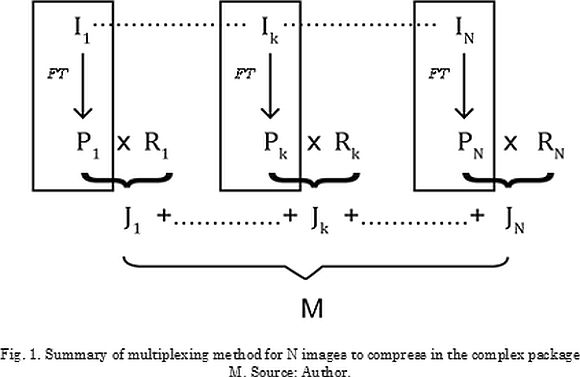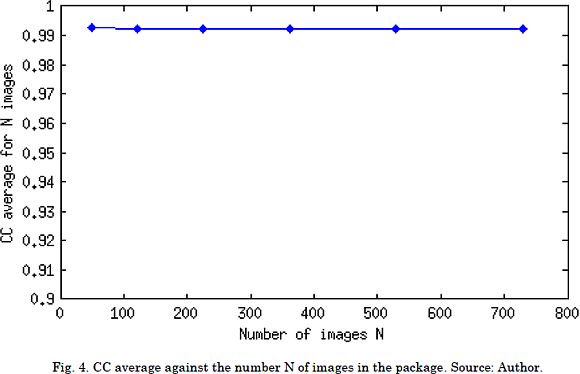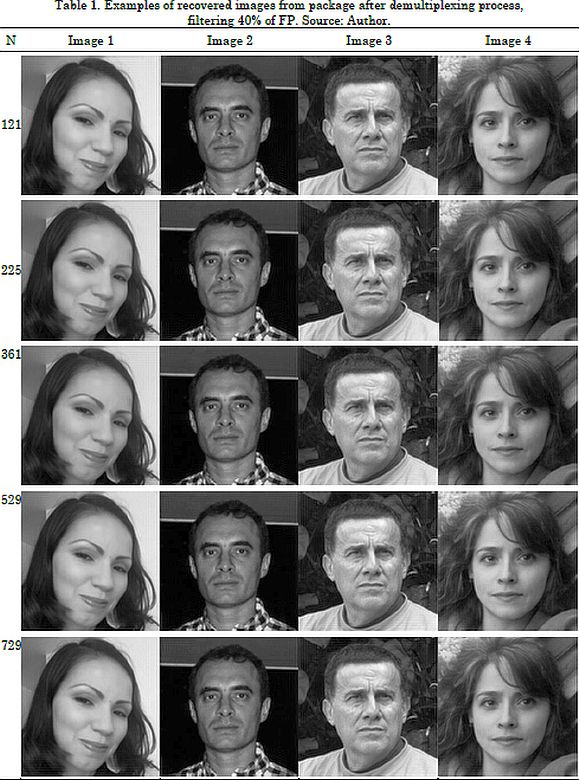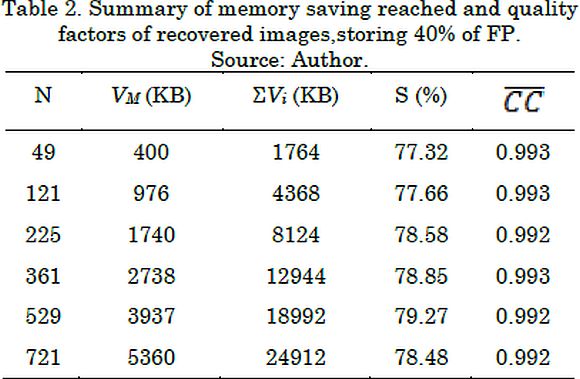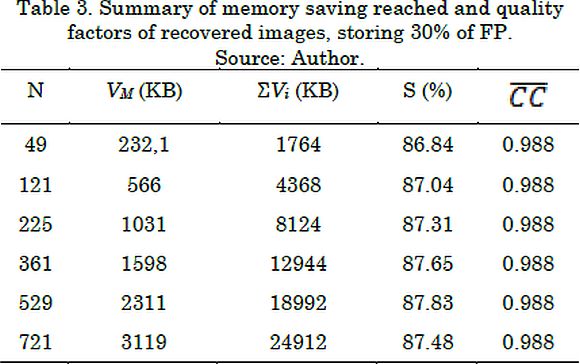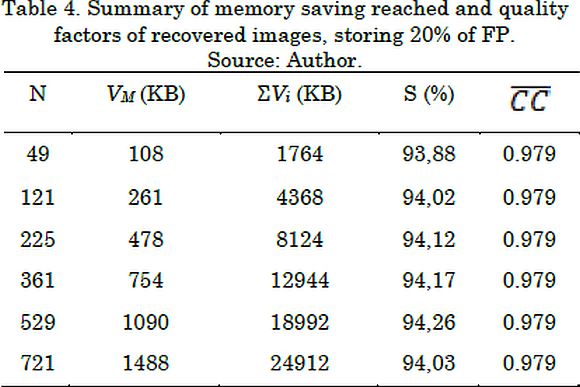Services on Demand
Journal
Article
Indicators
-
 Cited by SciELO
Cited by SciELO -
 Access statistics
Access statistics
Related links
-
 Cited by Google
Cited by Google -
 Similars in
SciELO
Similars in
SciELO -
 Similars in Google
Similars in Google
Share
TecnoLógicas
Print version ISSN 0123-7799On-line version ISSN 2256-5337
TecnoL. vol.20 no.39 Medellín May/Aug. 2017
Artículo de investigación/Research article
Analysis of the efficiency of a virtual-optical multiplexing method, by using theta modulation
Análisis de la eficiencia de un método de multiplexado óptico-virtual, usando modulación teta
Javier Vargas Valencia1
1 PhD in Physics, Grupo de Investigación GRITAD, Instituto Tecnológico Metropolitano, Medellín-Colombia, javiervargas@itm.edu.co
Fecha de recepción: 02 de abril de 2017/ Fecha de aceptación: 03 de mayo de 2017
Como citar / How to cite
J. Vargas-Valencia, “Analysis of the efficiency of a virtual-optical multiplexing method, by using theta modulation”, TecnoLógicas, vol. 39, no. 20, 2017.
Abstract
We present an efficient virtual-optical multiplexing method for compressing information contained in gray level images. The efficiency is measured using three parameters: quality factors of recovered images, memory saving percentage achieved, and number of multiplexed images in the package. Theta modulation techniques are applied, to process an N number of gray level images, by using a virtual-optical 2f architecture, from which we obtain a complex package M, to be stored as two images, amplitude and phase, in commercial formats. We apply pixel optimization and Fourier plane filtering to amplitude and phase images, respectively, storing only a percentage of the Fourier plane with a pixel dynamic range optimization. The stored package spends much less memory than individual images. The recovered images after the demultiplexing process are compared with the original ones by using correlation coefficient, obtaining high quality factors for decompressed images. We perform simulations, showing the efficiency of the proposed process, and our results are compared to the same factors reported in recent publications, making our improvements evident.
Keywords: Image multiplexing, Data Compress, Fourier Transform, Theta modulation, opto-digital simulation.
Resumen
Presentamos un método de multiplexado óptico-virtual eficiente, para comprimir información contenida en imágenes en niveles de gris. La eficiencia se mide usando tres parámetros: Factores de calidad de las imágenes recuperadas, porcentaje de memoria ahorrada, y número de imágenes multiplexadas en el paquete. Se aplican técnicas de modulación teta, procesando un número N de imágenes en niveles de gris, usando una arquitectura óptico-virtual 2f, obteniendo un paquete complejo M, que es almacenando como dos imágenes, amplitud y fase de M, en formatos comerciales. Se aplica un filtrado al plano de Fourier y una optimización a los píxeles de las imágenes de amplitud y fase, respectivamente, almacenando solo un porcentaje del plano de Fourier con una optimización al rango dinámico para los píxeles de cada una de ellas. El paquete almacenado gasta mucho menos memoria que las imágenes individuales. Las imágenes recuperadas después del proceso de desmultiplexado se comparan con las originales mediante el coeficiente de correlación, obteniendo para las imágenes recuperadas factores de calidad altos. Se realizan simulaciones que muestran la eficiencia del proceso propuesto, y nuestros resultados son comparados con los mismos factores reportados en publicaciones recientes, haciendo evidentes los avances logrados en este trabajo.
Palabras clave: Multiplexado de imágenes, Compresión de datos, Transformada de Fourier, Modulación teta, Simulación óptico-digital.
1. Introduction
Virtual-optical methods for information processing are a new alternative for optimizing and solving modern problems such as the storage and transmission of large amounts of infor-mation contained in image files, and for data in general, for both scientific and commercial purposes, among others. In particular, image multiplexing and processing for high volumes of information contained in gray level (GL) images, by using virtual-optical techniques have been investigated in recent years [1]–[15], where optical process are simulated looking for storing the information compressed in a package, which is, in general, complex. The usual proce-dures involve some virtual-optical architecture, like 2f, 4f, JTC, etc, and its purpose is to take a number of N images and to compress all of them in a package. In many cases, other additional encryption processes are performed to the package, but we are only interested in the multiplexing or compressing processes of these works. Then, the way in which the package is stored, and the quality factor of recovered information, play a fundamental role in the possible efficiency achieved by the method. We are interested in the efficiency of such processes, and with this in mind, we have made a revision of the main scientific published results in this area, looking for establishing possible factors to evaluate the efficiency of these virtual-optical multiplexing methods. We consider that to get the efficiency in the multiplexing process is fundamental to obtain memory saving with the storing of the package, with respect to the memory spent for the N original images. On the other hand, the efficiency also must depend on the acceptable or suitable quality factors for the recovered information. The storing and transmission for large volumes of information is not just a commercial issue, but it is also a question for computation itself. Implementing opto-digital methods is shown as an alternative that could mean significant savings in physical memory for information storage and transmission with a high quality factor of recovered information.
Nowadays there exists several formats to compress information which are widely known as the ZIP and the RAR. Some of them are exclusively made to compress images, like the JPG format. In the case of GL images, that are the ones that have been compressed in this work, the most efficient is the RAR format. This one offers a reduction of approximately 38% of the memory occupied by the original images. However, in this work we are focused on virtu-al-optical methods, and works we will analyze here are based on this type of techniques.
The published results by H. E. Hwang et al [14], show a maximum number of GL images, N=10, and illustrate an evident decreasing of correlation coefficient (CC) quality factor when increasing the N image number, obtaining an approximately value CC=0.93 for N=10. Other case to consider is the work by H. T. Chang et al [15], in which they evaluate the CC factor vs the N number of images in the multiplexed package, reaching a quality value CC=0.82 for N=9. Also, in this case, the quality factor CC decreases as N increases. In none of the two cases above is shown an evaluation of the percentage of memory saved obtained by their procedures. A known technique for image or information multiplexing is called theta modulation, it uses amplitude or phase gratings to separate the image information in demultiplexing stage. In the former work by Armitage [16], the gratings are introduced for information multiplexing under the concept of theta modulation, where the incline angle of the grating is proportional to the spatial frequency of the wave associated with each multiplexed message. In this work, two signals are multiplexed under this technique, and the authors do not present quality evaluation, neither storage memory saving achieved. More recently, Cabezas et al [3] proposed the use of a virtual-optical method, implementing amplitude sinusoidal gratings along with a 2f system to multiplex GL images avoiding crosstalk and by showing a reduction of package storage memory compared to the memory occupied by the individual images. They report a maximum number of N=12 images and a percentage of memory savings of approximately 89%, and do not report quality factors. Subsequently, these same authors report improvements with respect to the number of images, by using phase gratings instead of amplitude gratings, and use Normalized Root Mean Square Error (NRMSE) as quality factor; yet, a more complex architecture is used, consisting of a 4f system for multiplexing and an 8f system for demultiplexing stage [4]. In this work, they do not report memory savings, but, they show an increment of the image number to N=24, and reporting some quality val-ues as NRMSE=0.30 and 0.36 for two images. Those same techniques based on theta modu-lation were used by Mosso et al to multiplex and encrypt a complete video composed by GL images [17], while Barrera [18] and Trejos [19] claim for the use of a JTC system to make experimental multiplexing binary image messages in which the output plane presents location features similar to the ones exposed by Cabezas et al. in their works [3], [4].
In our previous work, we studied the effects of the quantization and transformation of pixel values of amplitude and phase images for a multiplexed package, and also the filtering of the Fourier plane (FP), in an information compression method via theta modulation techniques [20]. We have used virtual-optical simulations for multiplexing and demultiplexing image in-formation based on a 2f-correlator architecture and phase gratings. The memory savings achieved and quality factor CC for demultiplexed information were shown for three kinds of images: binary characters, QR codes, and GL human faces. In the present work we apply our compressing information method by using theta modulation techniques and an optimized procedure to store a complex multiplexing function M, and we also report new achievements about efficiency terms mentioned above. We make a Fourier transform (FT) to every image and then we multiply this FT by its corresponding special phase function: a positioning diffraction grating (PDG) that permits us locate the information in the output plane in demultiplexing stage. The sum of all these products constitutes the complex package M. The package M is made up of two images: amplitude and phase, in this work, for the first time we use com-mercial image formats to store amplitude and phase of the package. The procedure to de-multiplex the information of the nth image consists of using the complex conjugate (cc) of the nth grating, and multiplying it to the package, before the computing of the inverse Fourier transform. We compare the memory used to store the individual images and the package. The recovered information is compared to the original one by using the correlation coefficient CC as quality factor. All these parameters permit us to compare our results with the ones reported in recent publications.
2. Theta modulation method and package optimization
2.1 Multiplexing-demultiplexing method
The multiplexing process used is based on theta modulation techniques. It can be summarized as it is shown in Fig. 1. In order to pack Nth images in a complex package M, a FT is per-formed over each image Ik, obtaining a Pk complex function, where Pk = FT{ Ik }, and then, it is multiplied by its respective positioning diffraction grating (PDG), Rk, obtaining Jk= Pk Rk. The sum of all these products constitutes the complex package M, represented in (1):
The phase function or PDG, Rk, is given in terms of: wavelength, the propagation distance z between input and output planes, and the localization images central point in output plane of demultiplexing process (ak , bk ) as in (2).
These phase functions like in (2), are usually called gratings in recent publications and our treatment is similar to the one used by them [3], [4]. More deeply explanations about grat-ings can be seen in the classical book by Goodman [21]. The demultiplexing process can be simulated as an optical 2f system, and it consists of using a lens to perform the optical Fourier Transform of the multiplexed package, which, in an experimental stage is digitally manipulated before introducing it through amplitude and phase modulators in the input plane of the demultiplexing system. In this case the propagation distance z in (2) is the focal distance of the lens of the 2f system. To demultiplex the image number k, package M is multiplied by the cc of the corresponding PDG, Rk*. A propagation of the product MRk* through the 2f system is equivalent to an inverse FT, and give us the output k-image at the center of the output plane. The inverse FT of M Rk* is given by expression (3).
We distribute this sum of inverse FT, knowing that the inverse FT for each product in the sum is the convolution product of individual FT_s. We obtain a known function in terms of Dirac deltas. Then, k-th image is located by Dirac deltas in a spatial region well separated from each other, avoiding crosstalk. The Lk function is written for each image Ik as in the following expression:
Every term in (4) is located in different regions of the output plane, and its center is located by the PDG, concluding that, for every k'≠k, the image Ik´ has its center located at the point (ak´ - ak, bk´- bk), while the image Ik is located at the center of the output plane. Finally, the desired information Ik can be selected by filtering only the center of the output plane. In fact, this is an advantage of our method, because we only need an output plane as big as a single image, while other methods need much more space in the output plane. Filtering the output plane, selecting a small region ||Lk||, as big as a single image, we obtain only the image Ik, as in (5). This is the image which is compared to the corresponding original one, by using CC as quality factor.
2.2 Package storing optimization
Following the procedure recently reported in publication [20], in Fig. 2, we show some exam-ples of faces images that we want to store.
The theta modulation method described above, is applied to compress quantities of N= 49, 121, 225, 361, 529 and 721 images of human faces, 256x256 pixels in size. In each case the package is composed by two images concerning amplitude and phase. The next stage to optimize the package is the quantization and transformation of amplitude A and phase P im-ages for each one of the packages in the different N cases. Also the redundant information due to the analyzed symmetries of amplitude and phase images, is removed, and we finally store the optimized images A, and P, shown in Fig. 3 as an example, for N=121 images in package.
2.3 Efficiency
The aspects that play an important role in the optimization of efficiency of the method for compressing information, reducing the storing memory and retaining image quality for recovered information, are: The filtering of FP, the optimization of dynamic range through logarithmic transformation and bit quantization for pixels of amplitude and phase, and finally, the elimination of redundant information thanks to the symmetries of amplitude and phase. The criterion by which the efficiency of a compression method can be measured is based on its power to store information by reducing the required storage memory to the package and obtaining recovered information whose quality indexes are measurable and reach suitable values. The percentage of saved storage memory (S) has an ideal maximum limit of 100%, and it is calculated as in (6):
where VM is the memory occupied by the package in KB, while Vi is the memory occupied by the original image i, also in KB. It is clear that reaching a higher value for S depends on decreasing the ratio VM/ΣVi, as much as possible. All of this, will contribute to the optimization of memory. The quality of the retrieved information can be measured by the correlation coefficient (CC) expressed in (7), which compares the recovered image with the original one, and which can have values between -1 and +1, with +1 being the ideal value that implies that the recovered image is identical to the original.
where xij are the values of each pixel of the original image, while yij are the pixel values of the recovered image. To measure the efficiency Ec of the method we propose to take into account the percentage of memory saved and the average quality factor of the N images in the package as expressed in (8). The efficiency reaches an ideal limit value of 100%, and it is measured as the product of these two factors:
where CC is the average value of the CC quality factor for the N images in the package. Another factor contributing to the optimization of the efficiency Ec, is the number N of images in the package. In the revised works published in this area [13]–[15], [22], it is evident that increasing the number of images always decreases the average CC quality factor of the multiplexed N images. Another factor of quality to be considered for possible comparisons is the Normalized Root Mean Square Error NRMSE, which is defined in (9), where xij are the pixel values of the original image, and yij are the pixel values of the recovered image.
3. Results and discussion
We apply our previous cited multiplexing method to compress several quantities of N GL im-ages of human faces, 256x256 pixels in size. In the analyzed cases, we filter the FP, cutting only the percentage FP, taken from its center, and making an optimization process before storing the amplitude and phase images of package M. We analyze three cases, in which the FP filtering is different. As the percentage of filtered FP decreases, the quality of the recovered information diminishes, since the increasing of the loss of high frequencies is obvious, but, we gained in reduction storage memory.
3.1 Case 1. Filtering 40% of FP
We store 40% of the PF, with optimization values defined in our previous cited work, NA=4096, NUQ = 255, NF = 255. The package consists in two images, A and P of M, which are stored in image PNG format, whose choice was the result of an optimization process, which involves choosing a lossless format available commercially, easily accessible, and with 8 bitdepth. These characteristics were optimized in [20], [21], [23], looking for the package to occupy the smallest possible memory space. Fig. 4 shows the average CC behavior as a function of the number of N images in the package.
The compression and decompression processes are performed to the N images, performing the measurement of the CC to each recovered image, and comparing it to the original one, and calculating the average CC for each package containing N images. Our results indicate that the average CC value for the N images of the package is maintained above 0.993 even though the N number increases. In Table 1 we can see some examples of images recovered in each case.
Note that with the naked eye there are no changes in the information retrieved although N increases noticeably. These results are novel insofar as we do not know published results that show an N number of images in the package as high as the one we have achieved, maintain-ing the quality in the recovered information.
One of the advantages of our method is the use of a commercial format like PNG (or any other lossless format) to store the package, which facilitates its manipulation, storage and transmission. Now, the complete results of this process, in terms of memory saving and image quality are summarized in the Table 2, in which they appear, from left to right: num-ber N of images in package, memory VM spent for the package in A and P processed imag-es, memory expended for individual N images ΣVi, percentage of memory saving achieved S, and CC average value obtained.
The memory spent to store the information of the package images is much less than the one spent for all the N images. In this case, the average efficiency reached for all cases is the product of average values of terms S and CC : Ec =77.9%.
3.2 Case 2. Filtering 30% of FP
We store in this case 30% of the FP. Having the parameters NA = 4096, NUQ = 255, NF = 255. The stored package is saved again in image PNG format with 8 bitdepth. The quality of the retrieved information decreases as the percentage of the stored FP decreases, as in this case, but the storage memory saving increases, as is shown in Table 3, where the results of this case are summarized.
Also it can be seen the increasing in the memory saving percentage S, and the decreasing in the quality value of the recovered CC information respect to larger percentage of filtered FP analyzed before. In Fig. 5, we can observe some examples of the recovered information from the package when the percentage stored of FP is only the 30%, and for N=729. In this second case, the efficiency reached by the process gives us an average value Ec< =86.4%.
3.3 Case 3. Filtering 20% of FP
In this case, we only store 20% of the FP. Again, having the parameters NA = 4096, NUQ = 255, NF = 255. The stored package is saved in PNG format with 8 bitdepth. Again, we see the decreasing of the CC factor and the increasing of the storage memory savings. The results of this case are summarized in Table 4, where we can see the memory savings achieved at the expense of the quality of the recovered information.
In the Fig. 6, we can see some examples of recovered images for the case in which we filter the 20% of FP, and for N=729. In this third case, the efficiency reached by the method gives us an average value Ec=92.2%.
In all analyzed cases, the values CC and S remain almost constant as N increases. In this sense, what can be seen in the method is that the only limit in the N number of images in the package, is given for a very large number N, by computational resources, but with the modern availability of this kind of resources, this does not represent a very serious problem for the implementation of the method; in fact, it is an advantage.
4. Conclusion
We have proposed a virtual optical multiplexing method, based on theta modulation, which uses PDG phase gratings to multiplex and demultiplex information, optimizing pixel values for the amplitude and phase images of the package. The efficiency of the method has been demonstrated to achieve a significant saving of storage memory, while high quality values are obtained for the recovered information, which evidences that neither the saving percentage nor the CC quality factor depend on the number of N images in the package; they only depend on the percentage of the FP stored. The results reported in Tables 2, 3 and 4, in relation to the number of N images in the package, the average CC quality factor and the percentage of storage memory savings, represent substantial improvements to the work reported so far in this area of optical-virtual multiplexing, and these results can be compared with the same terms shown in the introduction of this article. In case 1, in which 40% of the FP is stored, 729 images are packaged, achieving a storage memory saving of 78.4%, while the average CC quality factor is always higher than 0.992, and their efficiency factor is Ec=77.9%. In the case of the storage of 20% of the FP, a memory saving of 94% is achieved, while the images still remain perfectly recognizable although their average CC value decreases to 0.979, and their efficiency factor is Ec=92.2%. On the other hand, in all cases the NRMSE quality factor is less than 0.1, which can also be compared with cited publications.
The perspectives of the method application are broad, and they include: encryption and multiplexing of images, videos, and their application to data processing in general, as an alterna-tive to reach substantial memory savings.
5. Acknowledgments
The author wish to thank to ITM for economical support and for computational resources of the HPC cluster from Parque I, and to MSc Luz Carime Carmona for her advising.
References
[1] A. Alfalou and C. Brosseau, “Optical image compression and encryption methods,” Adv. Opt. Photonics, vol. 1, no. 3, p. 589, Nov. 2009. [ Links ]
[2] X. Yong Liang, Z. Xin, Y. Sheng, and C. Yao Yao, “Multiple-image parallel optical encryption,” Opt. Commun., vol. 283, no. 14, pp. 2789-2793, Jul. 2010. [ Links ]
[3] L. Cabezas, M. Tebaldi, J. F. Barrera, N. Bolognini, and R. Torroba, “Optical smart packaging to reduce transmitted information,” Opt. Express, vol. 20, no. 1, p. 158, Jan. 2012. [ Links ]
[4] L. Cebezas, M. Tebaldi, J. Barrera, N. Bolognini, and R. D. Torroba, “Image enhancement in multiplexed data by using phase gratings in theta modulation encrypting techniques,” in Frontiers in Optics 2012/Laser Science XXVIII, 2012, p. FW3A.11. [ Links ]
[5] B. M. Hennelly, T. J. Naughton, J. McDonald, J. T. Sheridan, G. Unnikrishnan, D. P. Kelly, and B. Javidi, “Spread-space spread-spectrum technique for secure multiplexing,” Opt. Lett., vol. 32, no. 9, p. 1060, May 2007. [ Links ]
[6] N. Singh and A. Sinha, “Chaos based multiple image encryption using multiple canonical transforms,” Opt. Laser Technol., vol. 42, no. 5, pp. 724-731, Jul. 2010. [ Links ]
[7] X. Wang and D. Zhao, “Multiple-image encryption based on nonlinear amplitude-truncation and phase-truncation in Fourier domain,” Opt. Commun., vol. 284, no. 1, pp. 148-152, Jan. 2011. [ Links ]
[8] W. Liu, Z. Xie, Z. Liu, Y. Zhang, and S. Liu, “Multiple-image encryption based on optical asymmetric key cryptosystem,” Opt. Commun., vol. 335, no. 0, pp. 205-211, Jan. 2015. [ Links ]
[9] A. Alfalou, C. Brosseau, and N. Abdallah, “Simultaneous compression and encryption of color video images,” Opt. Commun., vol. 338, no. 0, pp. 371-379, Mar. 2015. [ Links ]
[10] R. Henao, E. Rueda, J. F. Barrera, and R. Torroba, “Noise-free recovery of optodigital encrypted and multiplexed images,” Opt. Lett., vol. 35, no. 3, p. 333, Feb. 2010. [ Links ]
[11] J. J. Huang, H.-E. Hwang, C. Y. Chen, and C. M. Chen, “Optical multiple-image encryption based on phase encoding algorithm in the Fresnel transform domain,” Opt. Laser Technol., vol. 44, no. 7, pp. 2238-2244, Oct. 2012. [ Links ]
[12] X. Deng and D. Zhao, “Multiple-image encryption using phase retrieve algorithm and intermodulation in Fourier domain,” Opt. Laser Technol., vol. 44, no. 2, pp. 374-377, Mar. 2012. [ Links ]
[13] H. Zhao, J. Liu, J. Jia, N. Zhu, J. Xie, and Y. Wang, “Multiple-image encryption based on position multiplexing of Fresnel phase,” Opt. Commun., vol. 286, no. 0, pp. 85-90, Jan. 2013. [ Links ]
[14] H. E. Hwang, H. T. Chang, and W. N. Lie, “Multiple-image encryption and multiplexing using a modified Gerchberg-Saxton algorithm and phase modulation in Fresnel-transform domain,” Opt. Lett., vol. 34, no. 24, p. 3917, Dec. 2009. [ Links ]
[15] H. T. Chang, H.-E. Hwang, and C.-L. Lee, “Position multiplexing multiple-image encryption using cascaded phase-only masks in Fresnel transform domain,” Opt. Commun., vol. 284, no. 18, pp. 4146-4151, Aug. 2011. [ Links ]
[16] J. D. Armitage and A. W. Lohmann, “Theta Modulation in Optics,” Appl. Opt., vol. 4, no. 4, p. 399, Apr. 1965. [ Links ]
[17] F. Mosso, J. F. Barrera, M. Tebaldi, N. Bolognini, and R. Torroba, “All-optical encrypted movie,” Opt. Express, vol. 19, no. 6, p. 5706, Mar. 2011. [ Links ]
[18] J. F. Barrera, S. Trejos, M. Tebaldi, and R. Torroba, “Experimental protocol for packaging and encrypting multiple data,” J. Opt., vol. 15, no. 5, p. 55406, May 2013. [ Links ]
[19] S. Trejos, J. F. Barrera, M. Tebaldi, and R. Torroba, “Experimental opto-digital processing of multiple data via modulation, packaging and encryption,” J. Opt., vol. 16, no. 5, p. 55402, May 2014. [ Links ]
[20] J. Vargas, D. Amaya, and E. Rueda, “Digital image compression for a 2f multiplexing optical setup,” J. Opt., vol. 18, no. 7, p. 75701, Jul. 2016. [ Links ]
[21] J. W. Goodman, Introduction to Fourier Optics, 2nd ed. McGraw-Hill, 1996. [ Links ]
[22] X. Yong Liang, X. Su, S. Li, X. Liu, and S. Zeng, “Key rotation multiplexing for multiple-image optical encryption in the Fresnel domain,” Opt. Laser Technol., vol. 43, no. 4, pp. 889-894, Jun. 2011. [ Links ].
[23] A. V. Valencia, “Optimización de un Sistema de Multiplexado Óptico Virtual y encriptación caótica,” Tesis Doctoral. Instituto de Física, Universidad de Antioquia, Medellín, Colombia, 2017. [ Links ]














